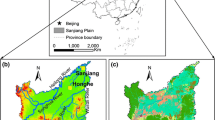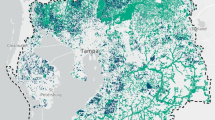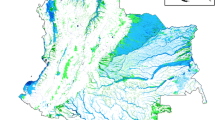Abstract
Historically, anthropogenic activities have contributed to the direct loss of wetland area, mostly due to agriculture and urban land uses. Urbanization also indirectly impacts wetlands at a landscape scale through altered wetland hydrology and change in the spatial configuration of wetlands in a watershed. In addition, beaver (Castor canadensis) create and modify wetlands in a landscape. Because of recent increases in urbanization and rising beaver populations, a raster-based geographic information system (GIS) was used to analyze the combined effects of humans and beavers on wetland area and types in the Chickahominy River watershed from 1953 to 1994. Results of the study revealed that 29% of the land changed during the 41-year study period, and wetland conversion constituted 7% of the total change. The major reason for wetland loss was the construction of two large water-supply reservoirs in the watershed, and most of the remaining wetland loss was due to urbanization. Wetland functions vary depending on wetland type, and the results of this study showed that 90% of the change in wetlands from 1953 to 1994 was a result of shifting between wetland types. Beaver-modified wetlands increased 274%, and beaver activity was responsible for 23% of the wetland change.
Similar content being viewed by others
Literature cited
Allen, A. O. and J. J. Feddema. 1996. Wetland loss and substitution by the Section 404 permit program in southern California, USA. Environmental Management 20:263–274.
Anderson, J. R., E. E., Hardy, J. T. Roach, and R. E. Witmer. 1976. A land use and land cover classification system for use with remote sensor data. U.S. Geological Survey Professional Paper 964.
Blackwell, W. P. 1949. The beaver makes a comeback. Virginia Wildlife 10:19–20.
Bogucki, D. J., G. K. Gruendling, E. B. Allen, D. B. Adams, and M. M. Remillard. 1986. Photointerpretation of historical (1948–1985) beaver activity in the Adirondacks. 1986 ASPRS-ACSM fall convention ASPRS technical papers. American Society for Photogrammetry and Remote Sensing. Anchorage, AK, USA.
Brady, S. J. and C. H. Flather. 1994. Changes in wetlands on non-federal rural land of the conterminous United States from 1982 to 1987. Environmental Management 18:693–705.
Brinson, M. M. 1993a. Changes in the functioning of wetlands along environmental gradients. Wetlands 13:65–74.
Brinson, M. M. 1993b. A Hydrogeomorphic Classification for Wetlands. U.S. Army Engineer Waterways Experiment Station. Vicksburg, MS, USA. Technical Report WRP-DE-4.
Brown, D. J., W. A. Hubert, and S. H. Anderson. 1996. Beaver ponds create wetland habitat for birds in mountains of southeastern Wyoming. Wetlands 16:127–133.
Callaway, R. M., and L. R. Walker. 1997. Competition and facilitation: a synthetic approach to interactions in plant communities. Ecology 78:1958–1965.
Cashin, G. E., J. R., Dorney, and C. J., Richardson. 1992. Wetland alteration trends on the North Carolina Coastal Plain. Wetlands 12:63–71.
Chesapeake Bay Program. 1997. Chesapeake Bay Wetlands The Vital Link Between the Watershed and the Bay. U.S. Environmental Protection Agency, Washington, DC, USA. EPA 903-R-97-002 CBP/TRS-160/97.
Cowardin, L. M., V. Carter, F. C., Golet, and E. T. LaRoe. 1979. Classification of Wetlands and Deepwater Habitats of the United States. U.S. Fish and Wildlife Service, Washington, DC, USA. FWS/OBS-79/31.
Dahl, T. E. 1990. Wetland Losses in the United States 1780s to 1990s. U.S. Department of the Interior Fish and Wildlife Service, Washington, DC, USA.
Dahl, T. E., and C. E. Johnson. 1991. Status and Trends of Wetlands in the Conterminous United States, Mid-1970s to Mid-1980s. U.S. Department of the Interior, Fish and Wildlife Service, Washington, DC, USA.
Dahl, T. E. and H. R. Pywell. 1989. National status and trends study: estimating wetland resources in the 1980s. p. 25–30. In D. W. Fisk (ed.) Wetlands Concerns and Successes. Symposium Proceedings, American Water Resources Association, Tampa, FL, USA.
Davis, M. M. 1994. Decision sequence for functional wetlands restoration. Water, Air and Soil Pollution 77:497–511.
Dennison, M. S. 1997. Wetland Mitigation Banking and Other Strategies for Development and Compliance. Government Institutes, Inc., Rockville, MD, USA.
Dennison, M. S., and J. F., Berry. 1993. Wetlands: Guide to Science, Law, and Technology. Noyles Data Corporation, Park Ridge, NJ, USA.
DCR. 1990. Department of Conservation and Recreation Division of Planning and Recreation Resources, Richmond, VA, USA. Chickahominy Scenic River Report. DOO775/PRR/SR.
Forman, R. T. T. and M. Godron. 1986. Landscape Ecology. Wiley & Sons, New York, NY, USA.
Frayer, W. E., T. J. Monahan, D. C. Bowden, and F. A. Graybill. 1983. Status and Trends of Wetlands and Deepwater Habitats in the Conterminous United States, 1950s to 1970s. Deptartment of Forest and Wood Sciences, Colorado State University, Ft. Collins, CO, USA.
Harbor, J. M. 1994. A practical method for estimating the impact of land-use change on surface runoff, groundwater recharge and wetland hydrology. Journal of the American Planning Association 60:95–108.
Hersperger, A. M. 1994. Landscape ecology and its potential application to planning. Journal of Planning Literature 9:14–29.
Hofstetter, R. H. 1983. Wetlands in the United States. p. 201–239. In A. J. P. Gore (ed.) Ecosystems of the World 4B Mires: Swamp, Bog, Fen and Moor Regional Studies. Elsevier Scientific Publishing Company, Amsterdam, The Netherlands.
Hupp, C. R., M. D. Woodside, and T. M. Yanosky. 1993. Sediment and trace element trapping in a forested wetland, Chickahominy River, Virginia. Wetlands 13:95–104.
Johnston, C. A. 1994. Cumulative impacts to wetlands. Wetlands 14:49–55.
Johnston, C. A. and D. H. Chance. 1974. Presettlement overharvest of upper Columbia River beaver populations. Canadian Journal of Zoology 52:1519–1521.
Johnston, C. A. and R. J. Naiman. 1990. The use of a geographic imformation system to analyze long-term landscape alteration by beaver. Landscape Ecology 4:5–19.
Jones, C. G., J. H. Lawton, and M. Shachak. 1994. Organisms as ecosystem engineers. Oikos 69:373–386.
Jones, C. G., J. H. Lawton, and M. Shachak. 1997. Fositive and negative effects of organisms as physical ecosystem engineers. Ecology 78:1946–1957.
Lemly, A. D. 1997. Risk assessment as an environmental management tool: considerations for freshwater wetlands. Environmental Management 21:343–358.
Malanson, G. P. 1993. Riparian Landscapes. Cambridge University Press, Cambridge, UK.
Maltby, E. 1986. Waterlogged Wealth Why Waste the World’s Wet Places? International Institute for Environment and Development. London, UK.
McCall, T. C., T. P. Hodgman, D. R. Diefenbach, and R. B. Owen, Jr. 1996. Beaver populations and their relation to wetland habitat and breeding waterfowl in Maine. Wetlands 16:163–172.
Mitsch, W. J. and J. G. Gosselink. 1993. Wetlands. Van Nostrand Reinhold Company, New York, NY USA.
Naiman, R. J. and J. M. Melillo. 1984. Nitrogen budget of a subarctic stream altered by beaver (Castor canadensis). Oecologia 62: 150–155.
Naiman, R. J., J. M. Melillo, and J. E. Hobbie. 1986. Ecosystem alteration of boreal forest streams by beaver. Ecology 67:1254–1269.
Naiman, R. J. C. A. Johnston, and J. C. Kelley. 1988. Alteration of North American streams by beaver. Bioscience 38:753–762.
National Research Council. 1995. Wetlands Characteristics and Boundaries. National Academy Press, Washington, DC, USA.
Nichols, C. 1997. Chickahominy River Watershed Wetlands Landscape Analysis. Draft. U.S. Fish and Wildlife Service Chesapeake Bay Field Office, Annapolis, MD, USA.
Pearson, S. M. 1994. Landscape-level processes and wetland conservation in the southern Appalachian Mountains. Water. Air and Soil Pollution 77:321–332.
Perry, J. and E. Vanderklein. 1996. Water Quality: Management of a Natural Resource. Blackwell Science. Boston, MA, USA.
Peters, D. D. 1989. Status and trends in the California Central Valley. p. 33–44. In D. W. Fisk (ed.) Wetlands Concerns and Successes. Symposium Proceedings, American Water Resources Association, Tampa, FL, USA.
Reimold, R. J. 1994. Wetlands functions and values. p. 55–78. In D. M. Kent (ed.) Applied Wetlands Science and Technology. Lewis Publishers, Boca Raton, LA, USA.
Remillard, M., G. K. Gruendling, and D. J. Bogucki. 1987. Disturbance by beaver (Castor canadensis KUHL) and increased landscape heterogeneity. p. 103–122. In M. G. Turner (ed.) Landscape Heterogeneity and Disturbance, Vol. 64, Ecological Studies. Springer-Verlag, Inc., New York, NY, USA.
Richardson, C. J. 1994. Ecological functions and human values in wetlands: a framework for assessing forestry impacts. Wetlands 14:1–9.
Smith, R. D., A. Ammann, C. Bartoldus, and M. M. Brinson. 1995. An Approach for Assessing Wetland Functions using Hydrogeomorphic Classification, Reference Wetlands, and Functional Indices. U.S. Army Engineer Waterways Experiment Station. Vicksburg, MS, USA. Technical Report WRP-DE-9.
Snodgrass, J. W. 1997. Temporal and spatial dynamics of beavercreated patches as influenced by management practices in a southeastern North American landscape. Journal of Applied Ecology. 34:1043–1056.
Swank, W. T., L. W. Swift, and J. E. Douglass. 1988. Streamflow changes associated with forest cutting: species conversion, and natural disturbances. p. 297–312. In W. T. Swank and D. A. Crossley, Jr. (eds.) Forest Hydrology and Ecology at Coweeta. Springer-Verlag. New York, NY, USA.
Tiner, R. W., I. Kenenski, T. Nuerminger, J. Eaton, D. B. Foulis, G. S. Smith, and W. E. Frayer. 1994. Recent Wetland Status and Trends in the Chesapeake Watershed (1982–1989). U.S. Fish & Wildlife Service, Annapolis, MD, USA.
Trettin, C. C., W. M. Aust, M. M. Davis, A. S. Weakley, and J. Wisniewski. 1994. Wetlands of the interior southeastern United States: conference summary statement. Water, Air and Soil Pollution 77:199–205.
Tripp, J. A. 1988. The status of wetlands regulation. Environment 28:45–46.
U. S. Census. 1990. Census of the population. Bureau of the Census. Washington, DC, USA.
Wakefield, P. 1982. Reducing the federal role in wetlands protection. Environment 24:6–13.
Walbridge, M. R. and B. G. Lockaby. 1994. Effects of forest management on biogeochemical functions in southern forested wetlands. Wetlands 14:10–17.
Author information
Authors and Affiliations
Corresponding author
Rights and permissions
About this article
Cite this article
Syphard, A.D., Garcia, M.W. Human- and beaver-induced wetland changes in the Chickahominy River watershed from 1953 to 1994. Wetlands 21, 342–353 (2001). https://doi.org/10.1672/0277-5212(2001)021[0342:HABIWC]2.0.CO;2
Received:
Revised:
Accepted:
Issue Date:
DOI: https://doi.org/10.1672/0277-5212(2001)021[0342:HABIWC]2.0.CO;2




